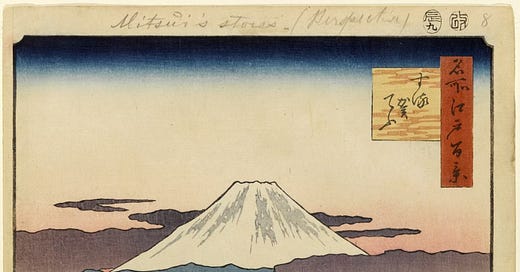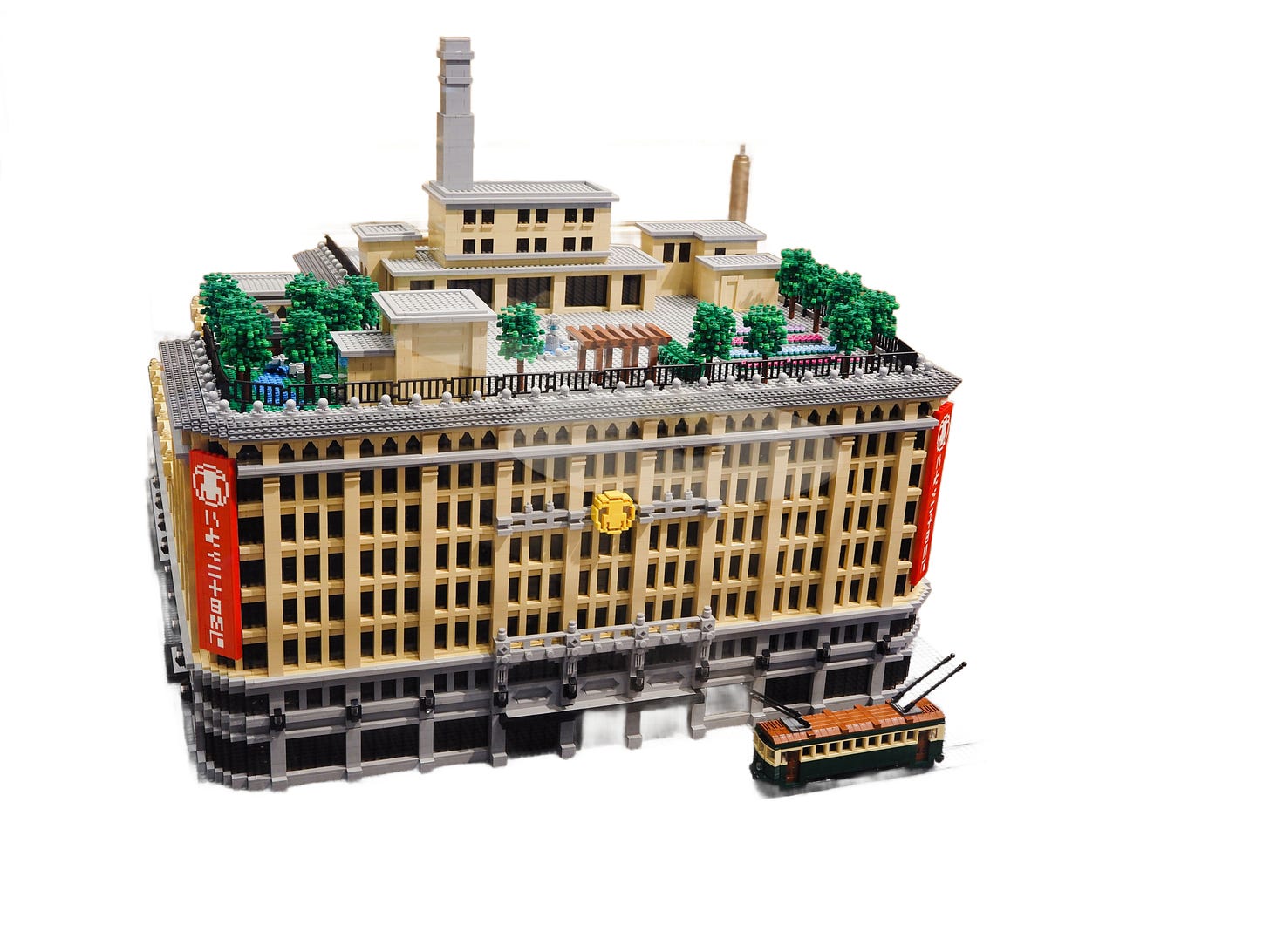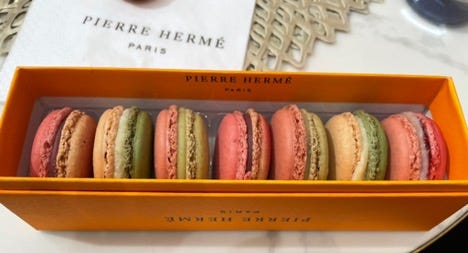Where Old Meets New: The Evolution of Tokyo's Culinary Landscape
It’s 10:00 am and I smell the aromas of kitchens that have been hard at work since long before dawn. It’s the smells of sugary confections and umami rich dishes. It’s the aromas of Japan, like taiyaki, a waffle, shaped like a fish filled with sweet bean paste. And it’s the aromas of my childhood -- freshly baked French bread. From behind the counters, I hear chefs giving instructions to young assistants making Kyoto style okonomiyaki (regional savory pancakes), and other chefs are placing trays of freshly baked gyoza (meat filled dumplings) into the display case.
Echoing above the sounds of the kitchens are the excited patrons, bustling through the narrow passages with an intentionality that is almost intimidating. Some confirming they’re in the right line, others appreciating the variety.
And as if in a culinary fairy tale, within arm’s reach of these world-class delicacies, I’m in the same spot at Hiroshige’s print Suruga-chō. Just like 1856, Mitsukoshi Department store is still on the left side of the street, and Mitsui Bank is still on the right. But unlike, the print, I’m not in the main street of Edozakura-dori, but under. Yes, on the B1 level -- where Tokyo department stores have created a culinary adventureland, fondly known as depachikas.
Depachika: A Feast for the Senses in Tokyo's Department Store Basements
The name, depachika, comes from the Japanese word depato, which means department store, and chika, meaning basement. Entering through large plate glass doors from the subway level, or descending into these food halls by the escalators, it’s clear you’re arriving into a curated world of culinary delight. Though this might seem a bit overwhelming, like most things in Tokyo, there’s a thoughtful organization to the depachikas.
The sweets are on one side, separated between Western and Japanese. The savories, too, are also separated by geographic region, with the central section reserved for seasonal or specialty vendors. Along one wall are the wine and liquor section, and along another are the meats and fresh foods.
Most department store depachikas have the same layout, which is helpful as some offer more than 30,000 products. Knowing where you are (and possibly where the exits are) is the first step. But most vendors are only at one depachika, so you can expect a different experience at each store.
Culinary Adventures in Nihonbashi: Mitsukoshi and Takashimaya
Mitsukoshi Nihonbashi – curated global delights
At Mitsukoshi’s flagship store in Nihonbashi, is Käfer, Munich’s premier sausage maker. They have a permanent place and you can enjoy the best meats that Germany has to offer year round.
Other vendors are seasonal. For Valentine season, in a humidity and temperature controlled chocolate “cave”, are boxes of chocolates from some of France’s most famous chocolatiers.
Takashimaya, Nihonbashi– regional food and roof-top garden
Just down the street from Mitsukoshi is Takashimaya, Tokyo’s second oldest department store. While the layout is the same at Takashimaya, it is known for an emphasis on Japanese regional foods. Purveyors from the various prefectures, usually manning the counter themselves, take immense pride in sharing and introducing their specialties. It’s a friendly environment and considered one of the best depachikas for sampling food.
On a clear day, escape the crowds and enjoy Takashimaya’s peaceful rooftop garden. Equipped with all the essentials for an impromptu picnic—tables, chairs, and even vending machines for drinks—this urban oasis allows you to savor your finds without waiting to get home.
Gourmet Gifts
A finally, don’t overlook the expertise you’ll find in the gourmet gift section. You’ll not only find tea sets, spices, jams, and honey, but also unique expertise. At Mitsukoshi Nihonbashi tea shop they have a master of the tea ceremony with credentials from Ministry of Health, Labour and Welfare to assist with choosing rare tea and tea cake recommendations.
While this description might sound like some combination of a gourmet grocery store, the airport gift shop, and a food court, it is much more. A visit to a depachika is an experience. It is the premier place Tokyoites go when they want to buy something special to share. Each item, no matter how small, is always meticulously hand wrapped and packaged with an eye toward presentation. And when you leave, not only will you carry away a one-of-a-kind delicacy, but you’ll also leave with a great adventure story to tell as well.
Navigating Tokyo's Culinary Maze: Tips and Tricks for Depachika Shopping
Unique baking time schedule at Johan Bakery, Mitsukoshi Nihonbashi
One of Paris’ oldest boulangeries, Johan, bakes the same French bread here at Mitsukoshi in Nihonbashi. Though they sell bread all day long, they limit the quantities of their specialty bread by a unique timetable and queue. Each day, Johan displays the baking timetable for their 10 most popular breads. (Don’t worry if you can’t read Japanese, use your Google Translate app to scan the list). 45 minutes before the scheduled baking time you can get a numbered ticket. Supplies are usually limited for specialty breads…today only two chocolate breads each.
Throughout the day, queues seem to form as though guided by an invisible hand. Pop-up vendors, who usually have a media following, typically have special queues for their products. Patrons might have received a message like this one through social media:
If you are looking for By Yang Blis’s products, please line up on the right side facing the Hanzomon Line exit on the 1st basement floor of the new building by 9:30 a.m. We will distribute numbered tickets by sales time to MI Card Plus members who are in the advance admission line.
“Secret” Help
Which line, what time, how many – wow – that’s taking the art of shopping to a new level! And navigating all these choices can be overwhelming. And yet, so many of the depachika patrons seem to have Zenlike patience as they knowledgeably navigate the counters. Aah, that would be the ones who have asked for help from personal shoppers, an island of calm!
As a convenience to everyone, depachikas have a fully staffed personal shopper desk who also speak English. These flawlessly attired assistants have a deep knowledge of which vendors have seasonal specialties, which vendors are selling regional delicacies and even which ones you can sample.
They also can give you some advice in the fresh fruit section, which is meant more for a special gift than an afternoon snack. Row upon row the jeweled-toned displays look like an art gallery and possibly just as valuable. The personal shopper can help explain the cultural significance of why a Taiyo no Tamago (Eggs of Sunshine) mango is selling for $250. (It’s rare, delicious, and a symbol that the recipient is worthy of such an exorbitant luxury).
And when you’re done shopping, you can bring your treasures to the domestic delivery counter or store them for later retrieval in a coin-operated refrigerated storage locker.
Not everyone in the depachika’s have deep pockets. At the end of the day, vendors who still have stock offer deep discounts. Savvy shoppers can plan their buying around these flash sales.
Window Shopping and Culinary Dreams: Imagining Tokyo's Foodscapes
Others, like myself, enjoy window shopping through the depachikas. I enjoy wandering through the regional foods section, frequently stopping and imagining endless possibilities and future experiences. What might it be like to sit on the beaches of Okinawa and taste their Gōyā chanpurū - gōyā (bitter melon).
Or visit Osaka and have fresh Takoyaki (Takoyaki - balls of grilled, savory batter with pieces of octopus inside.)
And then there’s the endless eye candy – literally.
It’s rare I leave empty handed. For me, it’s impossible to block out the siren songs of the pastries, each one unique, each telling a story. Should I take home macarons from Pierre Hermé?
Hmm, or what about from Matsuzaki the beautifully made rice cake crackers with the Nihonbashi bridge painted by craftsmen? Or, why choose, perhaps both!
As I leave Mitsukoshi, now standing where Hiroshige once captured Edo's spirit, the changes are clear but the vitality is the same. The blue banners with the Mitsui crest have transformed into Mitsui’s modern department store (Mitsukoshi) and a commercial bank with grand Roman columns (Mitsui Main Bank). Views of Mt. Fuji, once visible, are now replaced with skyscrapers. Yet, along the street, still there’s the same excitement and energy. Then as now, the main thoroughfare is filled with shoppers, carrying their Mitsukoshi treasures, and delighting in their high street shopping experience. Truly, this is where old meets new!


















Thank you! Mitsukoshi’s was my favourite B1